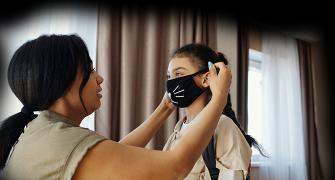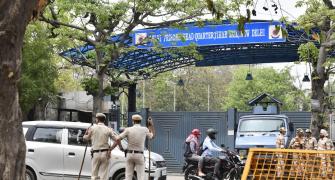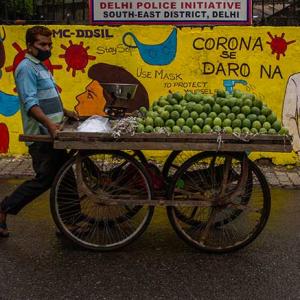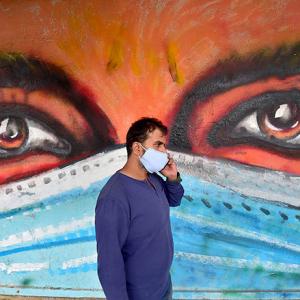'COVID-19 comes in, we have our immune response, the immune response overtakes COVID-19 in no time, usually within a day.'
'Fortunately, the majority who get infected will also be in that first category, where there is no damage and the virus is completely overcome.'

IMAGE: A healthcare worker collects a sample at a school turned into a COVID testing centre in New Delhi, August 3, 2020. Photograph: ANI Photo
Is COVID-19 like a thief in the night?
Dr Sanjeeth Peter explains why it is.
The heart surgeon, who is a critical care team member for COVID-19 patient care in Gujarat, sheds light, in a precise and simple way, on this viral disease and its numbers in India.
Like:
- Why we all might eventually get COVID-19.
- What is the significance of the national numbers for recovered/cured cases the government posts daily? Or of the recovery rates and mortality rates?
- Can actual case numbers link up with recovered case numbers in the absence of the total data?
- Why cured or recovered case numbers will obviously exceed active cases.
- If we can never get perfect with our testing, why are we testing?
- How 99 per cent of us have to recover from COVID-19.
- How COVID-19 affects individuals differently.
Dr Peter, who qualified from the Christian Medical College, Vellore, Tamil Nadu, and the Royal Melbourne Hospital, Australia, and has been operating for 25 years, is the director and chief cardiac surgeon at the DDMM Heart Institute, a super specialty hospital, in the small town of Nadiad, southeast Gujarat, about 60 km from Ahmedabad.
In Part I of this interview to Vaihayasi Pande Daniel/Rediff.com, Dr Peter graphically portrays how COVID-19 is quite like a burglar, who is stealthily trespassing, and breaking into your home ie illegally entering your body. Further he describes what happens during that unlawful entry, by the virus, into your lungs and cells.
There is now a lot of data being made accessible about active cases and recovered cases.
How is this important and what does it mean?
Someone I know well had a bad case of COVID-19. She has come out of it and her COVID-19 test is now negative.
But she was told that she still has COVID-19 in her lungs.
What does that mean?
Is she still an active case or not? Is she a recovered case?
First, (about this) personal acquaintance of yours, who was declared COVID-19 negative, but is COVID-19 positive in the lungs, etc, etc.
Obviously, she's going to be confused.
Does she have it?
Does she not?
Can she transmit? Can somebody else get it from her? Can she get it again?
These are the questions probably going through her mind.
That's why it's a confusing picture.
Let's look at it this way:
I like to give an analogy of a burglar. Let's say this burglar is COVID-19.
This burglar comes into your home to steal something and cause some damage.
We know that this particular burglar is susceptible to or doesn't like fire.
Let's use fire as an analogy for our body's immune response.
The first situation with a burglar named COVID-19:
In the first situation, if this burglar comes into your house, you (immediately) detect that this burglar has come in.
Before the burglar does anything or takes anything away, your systems are so alert, and your immune response is so alert, that you use fire and the burglar goes away.
Sixty per cent of our patients are going to be like that.
COVID-19 comes in, we have our immune response, the immune response overtakes COVID-19 in no time, usually within a day.
And then COVID-19 leaves.
So, you're left with no damage to your house. The house, in this case, is, let's say, both the body and specifically the lungs.
The second situation with a burglar named COVID-19:
In the second situation, when the burglar comes in, you realise this only after the burglar has opened the door and come into the house.
The characteristic of this burglar is that it replicates very quickly.
And that's what COVID-19 does. It replicates very quickly. It gets into the throat, then it gets into the lungs and it starts replicating in the cells.
That's when we realise that: 'Okay, this burglar has come in'.
Then we again use fire (our immune system response) to get rid of it, and we overcome it.
But in the bargain, maybe, we have also caused some damage -- maybe to a table next to it (the fire), or to another chair next to it, because it is fire after all.
But it is very minimal damage. We don't even realise it has burnt something that we probably hardly use.
We have overcome the burglar. The burglar has gone out.
So that's going to happen in another 40 to 50 per cent of patients.
There will be a slight response, in terms of maybe a fever, maybe even diarrhea, or maybe any of those other symptoms that (we know about COVID-19). We might even develop a little bit of incessant cough.
But in the second situation, everything will also be alright, because we have overcome the burglar.
The third situation with a burglar named COVID-19:
In the third situation, the burglar comes in and replicates so fast, that even our capacity (immune response) is not adequate to actually overcome him.
The burglar goes around destroying everything in that room in the house and at the end of that time period, the patient is dead.
This is probably what is happening in those patients who die within two or three days of (exhibiting) COVID-19 symptoms. I am sure you would have heard of patients who had symptoms and two or three days later they are dead.
This is what is happening to those patients. That means it is a viral replication per se that is probably responsible for the death, in such a situation.
The fourth situation with a burglar named COVID-19:
This is a classic situation. When the virus comes in and starts replicating, our immune response sets in.
And our immune response has been so good that by the 10th or 14th day it has got over the virus -- every single virus particle that there was, because our immune response was so good.
But it also triggered off that (too) much of a fire, that it destroyed its own self.
Cytokine storm or a hyperactive immune response?
Yes, so that's what it is.
It's destroyed itself.
Then you were left with no virus, sure.
In such situations, quite often what has been described, is that by Day 14, Day 15 or Day 16, they may not have any active viral particles there; they may not have any active viruses at all.
But yet they are sick on a ventilator, and they are on various other supportive therapies, because their immune response has been so unregulated, that it has responded and caused a massive fire in the situation.
Several of these patients succumb.
The fifth situation with a burglar named COVID-19:
In this next situation, the burglar comes in, starts replicating.
Our immune response is slow.
However, it picks up. It picks up enough to get over the burglar. But remember (with this) burglar lots of replication has been going on.
The immune response is going to have to deal with not just the original virus, but also the replicated viruses as well. A maximum amount of immune response is required.
During that immune response, obviously, there would be a lot of other damage. Damage to the kidneys maybe. There may be damage to the lungs to a large extent. There may be damages to other areas of the body. We were able to get rid of the virus, but we are also left with some damage, because the fire we had to use was that much.

IMAGE: Dr Sanjeeth Peter -- at DDMM.
Photograph: Kind courtesy ddmmheart/Facebook.comBut at least the immune response is able to get over the burglar -- COVID-19 in this case - and the burglar goes out. We have overcome it. There is a little bit of damage. Yet we are alive.
This is the situation your friend was in.
So, at the end of the day, what has happened?
The virus has gone off. There's no way that the virus is going to now replicate in the body and it is not there. Therefore, she cannot transmit the virus. But there has been adequate damage in the lungs itself.
And why is she being told that there are possibilities of transmission of the virus?
There is something called viral shedding.
These are viral particles or may be small particles of the virus that will continue to be shed. Maybe for 21 days. Maybe even longer. We don't know.
In all likelihood those particles are not capable of infecting and replicating.
When do you say a virus is potentially harmful? When it has the capacity to replicate.
These viral particles that you see, most often after the 14 or 15th day of the illness (COVID-19), are not the ones that can replicate and, therefore, I am saying the virus has gone off, but in this situation, you are left with...

IMAGE: A healthcare worker checks the oxygen level of a resident in Mumbai, August 2, 2020. Photograph: ANI Photo
A residue?
Yes, you are left with a residue, that's right.
That's not enough to infect. But she has been told (to be cautious), to be on the safe side, because, as I said, this is a new virus and we don't know.
In most cases -- 99 per cent of the time -- this viral residue or viral particles are not capable of infecting. But, just in case, she has probably been asked to take precautions.
So, if you look at the larger picture, she's no longer a case?
She's a healed case. She's not an active case.

IMAGE: A health worker collects a swab sample for a COVID-19 test at a hospital in Hyderabad, August 2, 2020. Photograph: ANI Photo
Treatment for various COVID-19 burglar conditions:
Let's look at each of these situations:
In the first situation -- where it is overcoming the virus by itself, the virus goes off, with no damage whatsoever -- nothing needs to be done.
In the second situation -- where it does come in, and where it can have some symptoms -- those symptoms need to be treated.
In the third situation (as well as the fifth) -- where it comes in and it is actively replicating and our immune system is late to respond or unable to overcome it ...maybe at this point, antivirals given early might help... Unfortunately, we don't have any specific antivirals against COVID-19. There is nothing specific against it. All the other antivirals (like remdesivir) are there, but they are not specific (to COVID-19).
And in the fourth situation -- where the immune response is so much that it is almost going on to destroy itself -- that's where we have to modulate it in a way which maybe, if specific markers of cytokines like IL-6* are high, then we give tocilizumab.
Immune response modulation seems to be the key and Dexamethasone has been proved to be beneficial to most patients in these categories (3,4 and 5).
The mainstay of treatment is Oxygen (various amounts and methods), Immune response modulating drugs (Steroids) and Anticoagulants (Heparin).
So that is the whole spectrum that we are seeing today.

IMAGE: A health worker collects a nasal sample from a child at a health centre in New Delhi, August 2, 2020. Photograph: Rahul Singh/ANI Photo
There seems to be a lot of emphasis in giving out data on the recovered cases, when India is still lagging behind in testing. Since we don't have complete data on who exactly is sick with COVID-19, are the recovered case numbers important?
Let us look at it in this way: I have kept emphasising that it is not a question of if, it is a question of when (the virus will come to us).
The majority are going to get infected.
Unless of course we have a vaccine.
Currently we are at a point where there is no vaccine. And there is no specific treatment against the virus -- as I said the antiviral that we usually give (specific to a virus), that's not there.
Therefore, in the absence of these two, we will have to have a majority of people getting infected.
Fortunately, the majority who get infected will also be in that first category (in the burglar analogy), where there is no damage and the virus is completely overcome.
Feature Presentation: Ashish Narsale/Rediff.com





 IMAGE: Dr Sanjeeth Peter -- at DDMM.
IMAGE: Dr Sanjeeth Peter -- at DDMM. 








